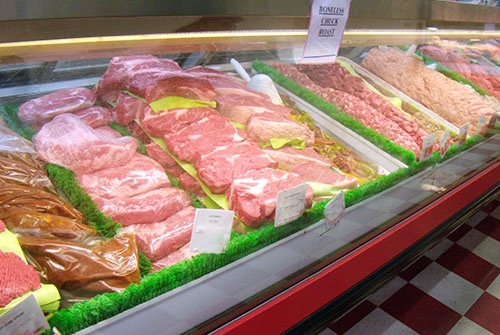Get the Best Deals on Fresh Meat at Bagley Farms Meat Market Edwardsville IL
Get the Best Deals on Fresh Meat at Bagley Farms Meat Market Edwardsville IL
Blog Article
Reveal the Art of the Butcher's Cut in a Modern Meat Market
In the ever-evolving landscape of modern-day meat markets, the butcher's cut has actually transcended its standard origins, merging old-time craftsmanship with contemporary techniques. What truly sets the contemporary butcher apart is their ability to build a much deeper connection in between consumers and the beginnings of their meat.
Evolution of Butchery Methods

The mid-20th century saw butchery techniques additionally improved by clinical insights right into muscle mass biology and meat aging, enhancing both tenderness and preference. Developments like vacuum cleaner product packaging and refrigeration prolonged item shelf-life, allowing butchers to expand offerings and improve quality assurance. This period likewise noted the increase of specialized tools, such as band saws and meat slicers, which boosted accuracy and efficiency in meat handling.
The 21st century has presented digital modern technology into the butchery world. Computerized systems now help in monitoring animal provenance and optimizing cuts to satisfy particular client choices. Furthermore, a revival in artisanal butchery has actually emerged, blending standard skills with contemporary understanding to accommodate consumers looking for moral and lasting meat alternatives. This advancement underscores a vibrant interplay between practice and innovation, conference contemporary demands while preserving the craft's heritage.

Comprehending Meat Cuts

Recognizing the details of meat cuts is crucial for both butchers and consumers seeking quality and worth. Each cut originates from a different component of the pet, giving distinct flavors, appearances, and cooking methods. Proficiency of these distinctions not only boosts cooking experiences but additionally maximizes the energy of each carcass. For butchers, accurate cuts reflect ability and respect for the craft, ensuring very little waste and optimal return.
The primary groups of meat cuts include primitive, sub-primal, and retail cuts. Butchers then break these down better into sub-primal cuts, before ultimately producing retail cuts offered to customers, like ribeye or tenderloin.
Understanding muscle mass make-up is essential; muscle mass made use of more often by the pet often tend to be tougher and are best suited for sluggish cooking techniques, while less-used muscular tissues, like those found in the loin, are much more tender and suitable for cooking or roasting. Knowledge with these differences empowers consumers to make educated options, improving their cooking undertakings.
Choosing High Quality Meat
Selecting the appropriate meat entails greater than simply choosing a visually appealing piece from the display. The art of picking top quality meat calls for a discerning eye and understanding click reference of particular attributes that signify quality and quality. Pay focus to the shade; beef ought to have a bright, cherry-red tone, while lamb must display a soft pink tone, and pork a light pink. This shows the meat is fresh and hasn't been exposed to oxygen for as well lengthy.
Second of all, consider the marbling, which describes the white flecks of fat within the muscular tissue. Appropriate marbling is a browse around these guys vital sign of tenderness and flavor, as it thaws during food preparation, enhancing the meat's juiciness. Bear in mind, higher marbling often associates with exceptional high quality cuts, such as USDA Prime.
Appearance is one more critical element; meat needs to feel strong to the touch, not slimy or excessively soft. In addition, be mindful of the aroma. Fresh meat should have a tidy, neutral scent, devoid of any kind of sour or off-putting odors.
Coupling Cuts With Cooking Techniques
Effectively combining cuts of meat with the ideal food preparation approaches is essential for accomplishing ideal taste and appearance. These approaches boost the meat's natural flavors and guarantee a juicy surface.
On the other hand, harder cuts like brisket and chuck roast are abundant in collagen, which damages down right into gelatin when cooked slowly. These cuts are perfect for braising or slow roasting, allowing the meat to tenderize over time and create deep, intricate tastes. In a similar way, cuts such as short ribs and pork shoulder get on well with slow-cooking methods, where extended cooking times change their durable structures into succulent recipes.
Lamb shanks and oxtail, which need prolonged cooking to soften, are best candidates for cooking or sluggish simmering. These techniques coax out rich, passionate flavors while maintaining dampness. By comprehending the distinct characteristics of each cut, cooks and home cooks alike can boost their cooking developments, making certain each recipe is both pleasing and memorable.
The Butcher's Duty Today
Browsing the evolving landscape of the contemporary meat market, the butcher's role today prolongs past mere preparation of cuts. Contemporary butchers are cooking artisans, teachers, and supporters for sustainable methods.
Along with crafting precise cuts, butchers currently engage straight with consumers, providing cooking suggestions and tailoring selections to fit specific needs and preferences. Their knowledge in meat aging, marbling, and taste accounts empowers consumers to make educated choices, boosting their culinary experiences. This customized service exhibits the butcher's advancing role as a trusted consultant in the kitchen area.
In addition, butchers are pivotal in reducing waste, using entire pets to develop varied items such as sausages and supplies - bagley farms meat market edwardsville il. This thorough approach not only respects the animal but likewise lines up with contemporary sustainability goals. In this method, the contemporary butcher symbolizes both practice and technology, adjusting to an ever-changing market while maintaining the virtuosity and honesty of their craft

Conclusion
The modern butcher's craft delicately weaves standard techniques with modern-day advancements, highlighting lasting methods and moral sourcing. Mastery in understanding varied More about the author meat cuts and quality signs empowers butchers to supply informed referrals, aligning details cuts with optimal food preparation methods. This experience not only boosts culinary experiences however additionally enhances the link between consumers and the beginnings of their food. By honoring historic techniques while embracing modern needs, the butcher's role continues to be vital in today's advanced meat market.
Report this page